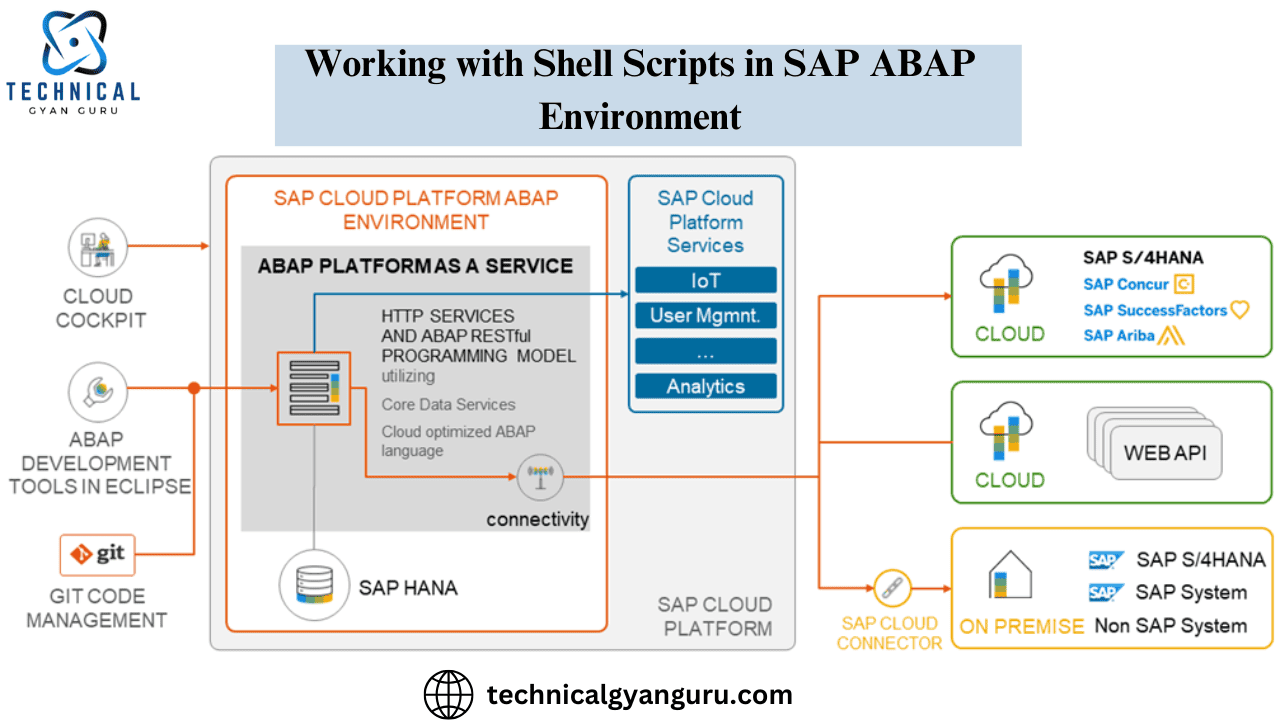
For a beginner in SAP, it might sound strange when I say that we can use Unix Shell Scripts in SAP ECC. Indeed, you read it right! Working with Shell Scripts in SAP ABAP Environment allows us to leverage the benefits of shell scripts within our own SAP landscape. This integration can significantly enhance our ability to automate and manage tasks effectively.
Allow us to take an instance of putting a document at a FTP area utilizing a Shell Content.
Note : We can utilize the standard Capability Modules like FTP_R3_TO_SERVER and a lot more FTP FMs. In any case, we need to exhibit Shell Content here, accordingly we will utilize this situation to become familiar with the usage of Shell Contents in this article.
Steps to Follow:
- Get a UNIX Expert to Write a Script for you and upload it in AL11 with an Extension ‘.SH’.
We have composed a content referencing the objective, certifications to get to the envelope on objective FTP area and a few orders to move the document. Then we saved it in ‘/TMP/ENCL’ registry on AL11 with the name ‘FTP.SH‘.
Following is an example of the script:
Dir="/test/output/" Dest=/TEST/ HOST=999.99.999.99 #IP of destination server USER=user PASSWD=pwd cd $Dir ftp -n -i -v $HOST <<END_SCRIPT quote USER $USER quote PASS $PASSWD bin #hash prompt cd $Dest mput $1 quit END_SCRIPT
- Create an external Operating System Command
We can make an outer Working Framework Order utilizing SM69 T-code. Click on Make button.

Give Working framework name as AIX for UNIX.
Enter the area of Shell Content in Working Framework Order field (as featured in yellow beneath).

- Get back to Program in ABAP
We can utilize Capability Module ‘SXPG_COMMAND_EXECUTE‘ to execute an order made from SM69.
Following is a straightforward Example Report for our utilization case:
REPORT Elearning.co.in
DATA : lv_file TYPE btcxpgpar VALUE ‘/tmp/demo.txt’. ” File to be transferred
CONSTANTS : c_ftp TYPE sxpgcolist-name VALUE ‘ZFTP_TEST’. ” Command name
***Move the Files to the shared folder
CALL FUNCTION ‘SXPG_COMMAND_EXECUTE’
EXPORTING
commandname = c_ftp
additional_parameters = lv_file
stdout = ‘X’
stderr = ‘X’
EXCEPTIONS
no_permission = 1
command_not_found = 2
parameters_too_long = 3
security_risk = 4
wrong_check_call_interface = 5
program_start_error = 6
program_termination_error = 7
x_error = 8
parameter_expected = 9
too_many_parameters = 10
illegal_command = 11
wrong_asynchronous_parameters = 12
cant_enq_tbtco_entry = 13
jobcount_generation_error = 14
OTHERS = 15.
IF sy-subrc <> 0.
* Implement suitable error handling here
MESSAGE ‘Error Occurred’ TYPE ‘E’.
EXIT.
ELSE.
MESSAGE ‘FTP successful’ TYPE ‘S’.
ENDIF.
Bingo!!
We have effectively made a report which calls an operating system Order and execute a Unix Content. The above report would peruse the AL11 document in the Application Server which thusly would execute the orders written in it. You can compose anything in the content in AL11 document according to your task need. In another client prerequisite, we utilize the Shell Content to compose document from FTP server to Drain Application Server.
Trust you preferred this article. Cheerful Learning.
If you have any questions, please feel free to leave them in the comments section below. I will personally respond to all your queries, especially those related to working with shell scripts in the SAP ABAP environment.
YOU MAY LIKE THIS
ABAP on SAP HANA. Part III. Debugging in ADT
Power of Parallel Cursor in SAP ABAP
OData in SAP ABAP: Streamlining Data Exchange and Integration








